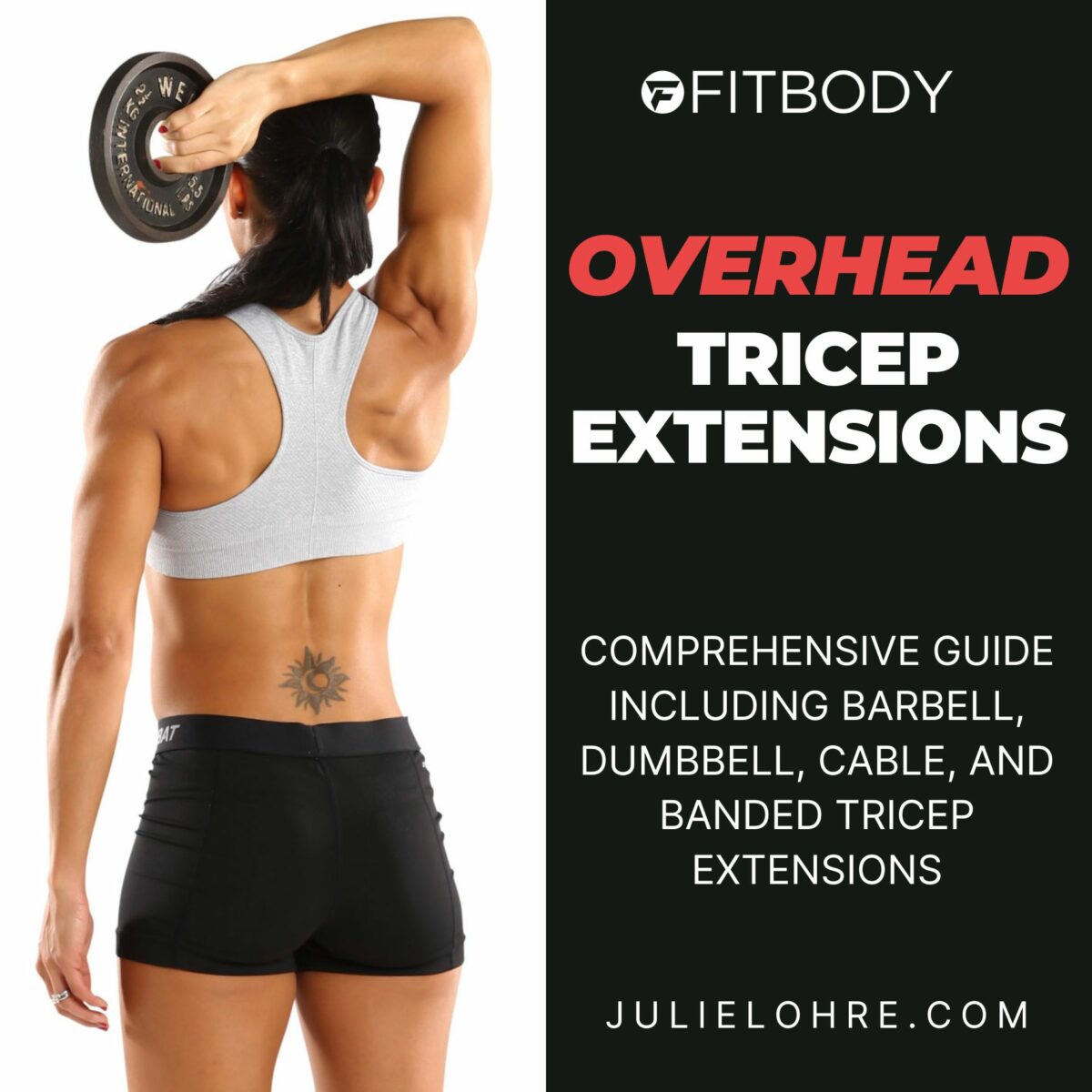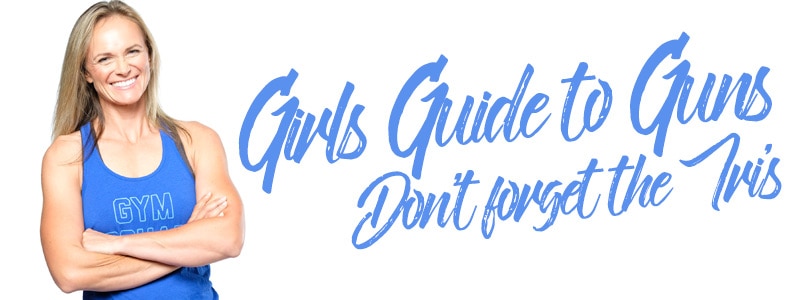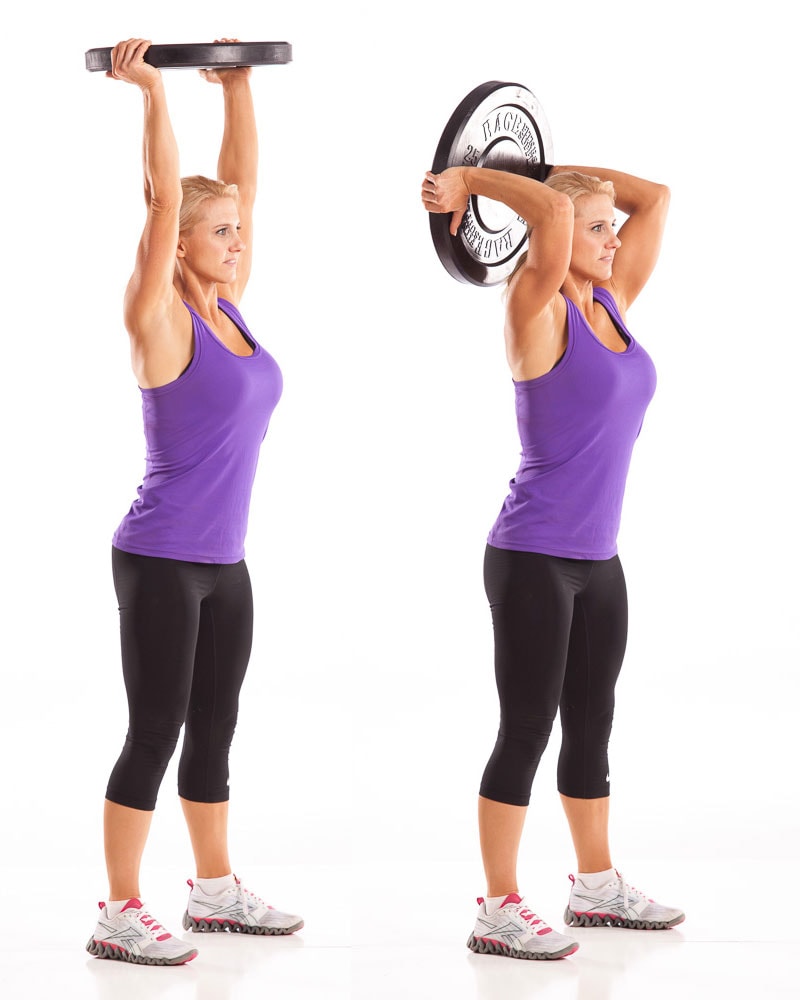
Overhead Tricep Extension Exercise
Table of Contents:
What Muscles do Overhead Tricep Extensions Work?
What are the Best Ways to Build the Triceps?
How to do a Tricep Overhead Extension
Tricep Overhead Extension Form Checklist
Overhead Tricep Extension Exercise Variations:
Cable Overhead Tricep Extension
Dumbbell Overhead Tricep Extension
Barbell Overhead Tricep Extension
Plate Overhead Tricep Extension
Band Overhead Tricep Extension
The overhead tricep extension is not just another arm exercise; it’s a focused approach to strengthening and toning the triceps in particular, the muscles at the back of your upper arms. Often overshadowed by bicep workouts, the triceps are equally important for a balanced arm strength and a well-defined appearance. By elevating the arms above the head, this exercise uniquely isolates the triceps, ensuring that they do the heavy lifting, quite literally.
As a women’s fitness expert, I always look for movements that allow me to get the most out of an exercise for my online fitness coaching clients and utilize the equipment they have available. Including movements like dumbbell or cable overhead tricep extensions are an excellent choice for those looking to enhance muscle definition, improve upper body strength, and even aid in performing daily activities more effectively.
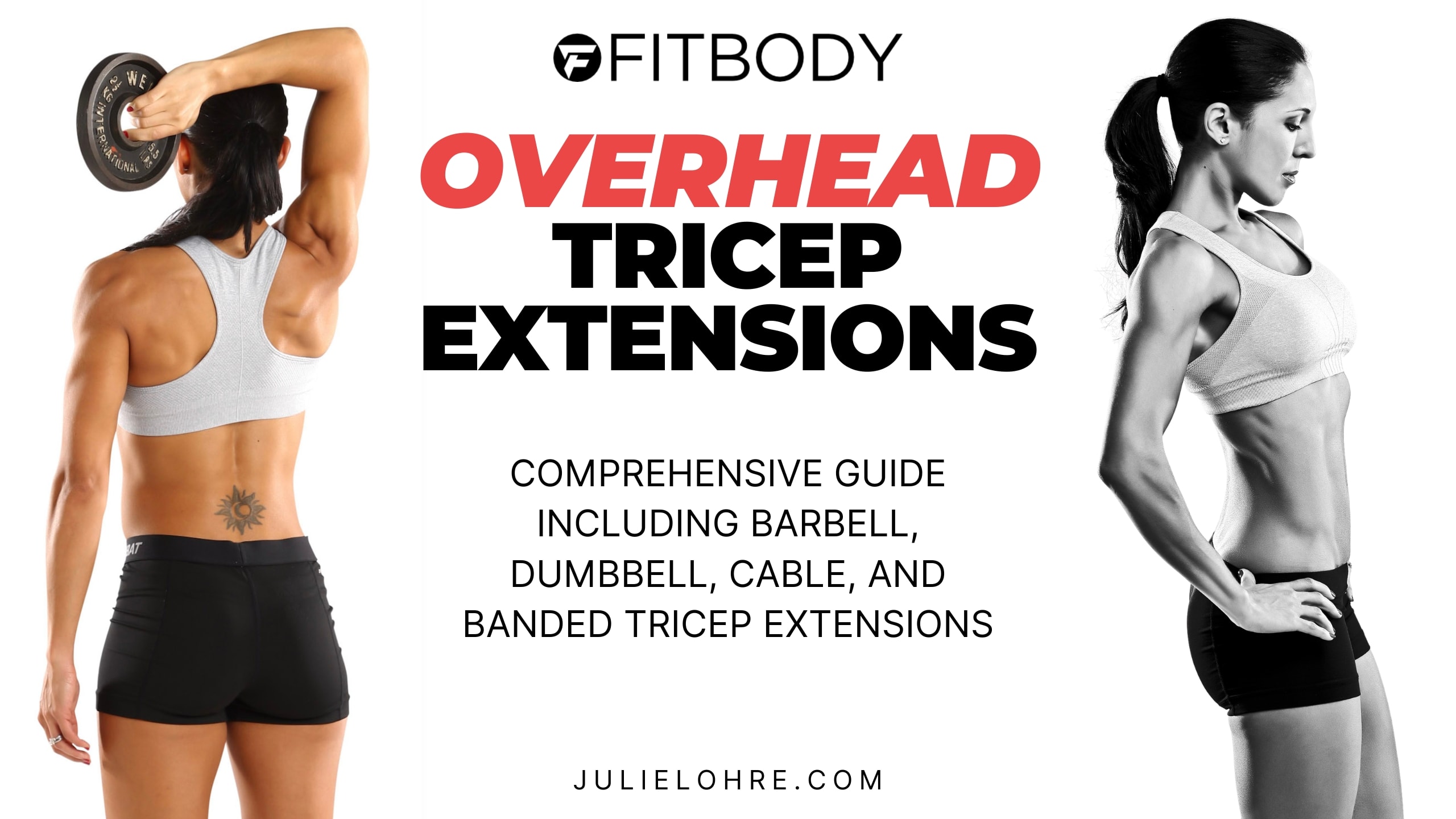
For beginners, it’s crucial to start with a weight that is manageable yet challenging. The beauty of the overhead tricep extension lies in its simplicity and adaptability. You can perform it with a range of equipment, from dumbbells to kettlebells, barbells to cables or even a resistance band. The key is to maintain a good form – keeping your elbows close to your head and avoiding any unnecessary shoulder movement. This ensures maximum engagement of the tricep muscles throughout the whole overhead tricep extension. No matter your exercise experience level, your arm workout routine should incorporating this effective exercise. When you do, it can bring about noticeable changes in your arm strength and appearance. Stay tuned as I guide you through the steps to perfect your form and maximize the benefits of the overhead tricep extension.
What Muscles do Overhead Tricep Extensions work? Actually… what are triceps? Understanding Tricep Anatomy.
The triceps brachii is a major muscle of the upper arm in the human body. The triceps run along the humerus (the main bone of the upper arm) between the shoulder and the elbow. Along with the biceps, it enables extension and retraction of the forearm. When the triceps are contracted, the forearm extends and the elbow straightens; if the triceps are relaxed and the biceps flexed, the forearm retracts and the elbow bends. The triceps also serve to stabilize the shoulder joint at the top of the humerus. Specially, overhead tricep extensions engage the following muscles / muscle groups:
- Triceps Brachii: This muscle has three heads – the long, medial, and lateral heads. The overhead tricep extension especially targets the long head of the triceps, which is not as effectively engaged in other tricep exercises like push-downs.
- Core Muscles: To a lesser extent, the overhead tricep extension exercise also engages the core muscles, including the abs and lower back. Maintaining stability during the movement requires slight engagement of these muscles, which helps in improving overall balance and posture.
- Shoulder Stabilizers: While the shoulders are not the primary focus of the exercise, the stabilizing muscles around the shoulder joint are engaged to maintain proper form and support the movement of the arms.
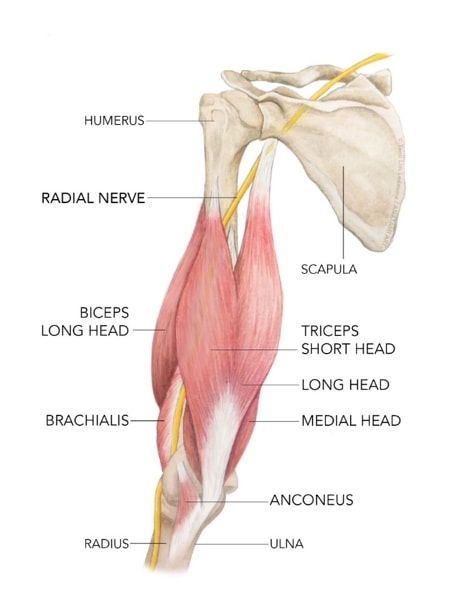
By focusing on the triceps, the overhead tricep extension helps in developing upper arm strength and muscle definition. It’s an effective exercise for those looking to tone their arms and improve their upper body strength.
What are the Best Ways to Build the Triceps?
Most women want to firm and tighten the back of their arms and building the triceps muscles are the a great way to do that. There are a variety of exercises that you can use to work that area. Start with the overhead tricep extensions that I have lined out here. From there, you can move on to a full workout specifically designed for that area. I have put together some of my favorite exercises for the back of the arms here:
How to do a Tricep Overhead Extension
To perform an overhead tricep extension:
- Stand with your feet shoulder-width apart, holding a weight (like a dumbbell, barbell, or plate) in both hands. Lift the weight overhead, extending your arms fully.
- Keep your elbows close to your ears, and your upper arms stationary. This is your starting position.
- Slowly bend your elbows to lower the weight behind your head. The movement should happen only at the elbows.
- Lower the weight until your forearms are just beyond a 90-degree angle with your upper arms. Keep your elbows in and avoid flaring them out.
- Extend your arms back to the starting position, using your triceps to lift the weight.
- Maintain control throughout the exercise. Repeat for the desired number of repetitions.
Tricep Extension Form Checklist
While the specifics are going to vary based on the equipment you use, here is my form check list for a general tricep overhead extension.
- Elbow Positioning: Keep elbows close to the head and pointed straight ahead to ensure the triceps are properly targeted and to reduce strain on the shoulder joints.
- Controlled Movements: Move slowly and control the weight throughout the entire range of motion to maximize muscle engagement and reduce the risk of injury.
- Correct Weight Selection: Choose a weight that is challenging yet manageable to maintain proper form and prevent muscle strain or overexertion.
- Avoid Locking Elbows: At the top of the movement, avoid fully locking the elbows to maintain tension on the triceps and protect the elbow joint.
- Stable Core: Engage your core throughout the exercise to maintain balance and stability, especially when using heavier weights.
- Breathing Technique: Breathe out as you lift the weight overhead and inhale as you return to the starting position to maintain a steady rhythm and support the movement.
- Start Position: Begin with the weight directly overhead and arms fully extended to properly align the body and prepare the muscles for the exercise.
- Avoid Overextending: Don’t lower the weight too far behind your head, as this can put unnecessary stress on the shoulder joints and reduce the effectiveness of the exercise.
- Posture Check: Maintain a straight back and avoid arching your lower back, which can lead to spinal strain and reduced effectiveness of the exercise.
Overhead Tricep Extension Exercise Variations
Now that you have a good understanding of tricep anatomy, have one through my overhead tricep extension form checklist, and why including upper arm exercises in your workouts is important, I want to share the unique versatility of the overhead tricep extension exercise. I love that this exercise can be performed with various types of equipment, each offering its unique benefits and challenges. Exploring these variations allows women to tailor their workout to their specific goals, equipment availability, and personal preferences.
From the classic dumbbells to barbells, plates, cables, and resistance bands, each equipment type adds a distinctive twist to the exercise, impacting the muscles slightly differently. Below, I am going to dive into overhead tricep extension variations using different workout equipment, examining the nuances of each variation and how they contribute to muscle strength, endurance, and overall arm development.
Overhead Tricep Extension Cable or Rope
Benefits of Using a Cable Machine for Overhead Tricep Extensions:
- Constant Tension: Provides steady resistance throughout the exercise, enhancing muscle engagement and growth.
- Smooth Movement: Offers controlled motion, reducing the risk of jerking or momentum that can lead to injury.
- Adjustable Resistance: Allows for easy modification of resistance level, accommodating different strength levels and progression.
Drawbacks of Using a Cable Machine for Overhead Tricep Extensions:
- Limited Availability: Requires access to a gym or a home gym with a cable machine, which may not be readily available for everyone.
- Less Functional Movement: Cable machines offer less natural movement patterns compared to free weights, potentially reducing functional strength gains.
- Queue Time in Gyms: In a gym setting, there can be waiting times to use popular cable machines, disrupting workout flow.
Performing overhead tricep extensions with a cable machine and the rope attachment introduces a unique element to this classic exercise, offering continuous tension throughout the movement. This constant resistance from the cable machine ensures that the triceps are engaged and under strain during both the concentric (lifting) and eccentric (lowering) phases of the exercise. This feature is particularly beneficial for muscle hypertrophy and endurance building. The smooth, steady resistance provided by the cable also allows for more controlled movements, reducing the risk of jerking or momentum that can sometimes occur with free weights. Furthermore, the cable’s versatility allows for adjustments in resistance and angle, enabling a more tailored workout experience. This adaptability makes it suitable for various fitness levels, from beginners to advanced athletes, and allows for progressive overload as strength increases.
Another unique aspect of using a cable for overhead tricep extensions is the ability to maintain a consistent angle of resistance relative to the arm. This is particularly beneficial for targeting different heads of the tricep muscle. Adjusting the height of the cable can shift the focus slightly between the long, medial, and lateral heads of the triceps, allowing for a more comprehensive tricep development. Additionally, the cable setup can help in maintaining better form by providing a guide for the movement path, reducing the likelihood of improper form that could lead to injury. The cable overhead tricep extension is not only effective for building tricep strength and definition but also for enhancing overall arm aesthetics and functional upper body strength.
Overhead Tricep Extension Dumbbells
Benefits of Using Dumbbells for Overhead Tricep Extensions:
- Increased Range of Motion: Offers greater freedom of movement, enhancing muscle stretch and contraction.
- Versatility: Suitable for a variety of fitness levels and can be easily incorporated into different workout routines.
Drawbacks of Using Dumbbells for Overhead Tricep Extensions:
- Stabilization Challenge: Requires more effort to stabilize the weights, which can be challenging for beginners.
- Limited Load: Compared to barbells, dumbbells often have a lower weight limit, which might be restrictive for advanced users seeking heavier lifts.
- Risk of Incorrect Form: Without proper guidance, there’s a higher chance of performing the exercise with incorrect form, leading to reduced effectiveness or injury.
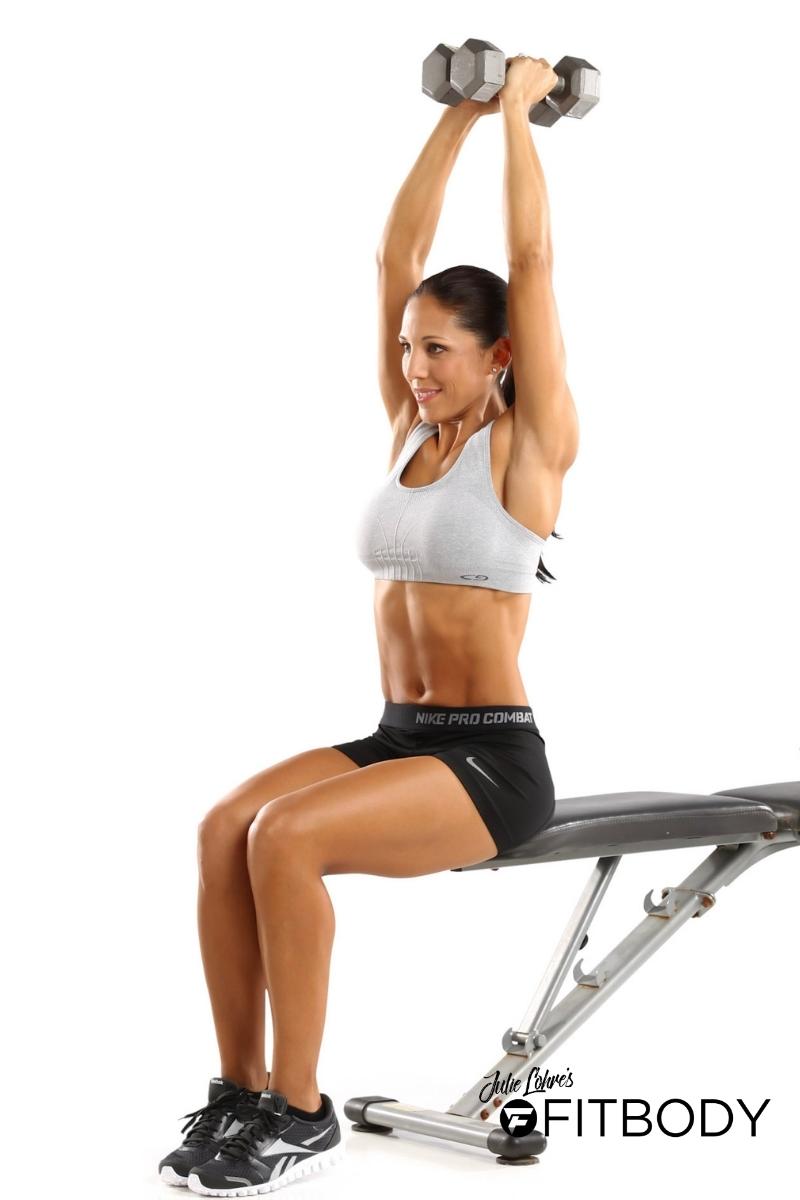

The dumbbell overhead tricep extension is particularly beneficial because it isolates the triceps, allowing for focused muscle engagement and growth. When performed with a dumbbell, the overhead tricep extension uniquely challenges the stabilizing muscles in the arms and shoulders, providing a comprehensive workout that goes beyond mere tricep strengthening. Using a dumbbell allows for a greater range of motion compared to using a barbell or other equipment. This increased range of motion enables deeper muscle engagement, particularly of the long head of the triceps, which is crucial for full muscle development and achieving that coveted arm definition. I often give my clients the choice between doing this movement in a seated position or standing and using one dumbbell turned sideways, or two dumbbells held together.
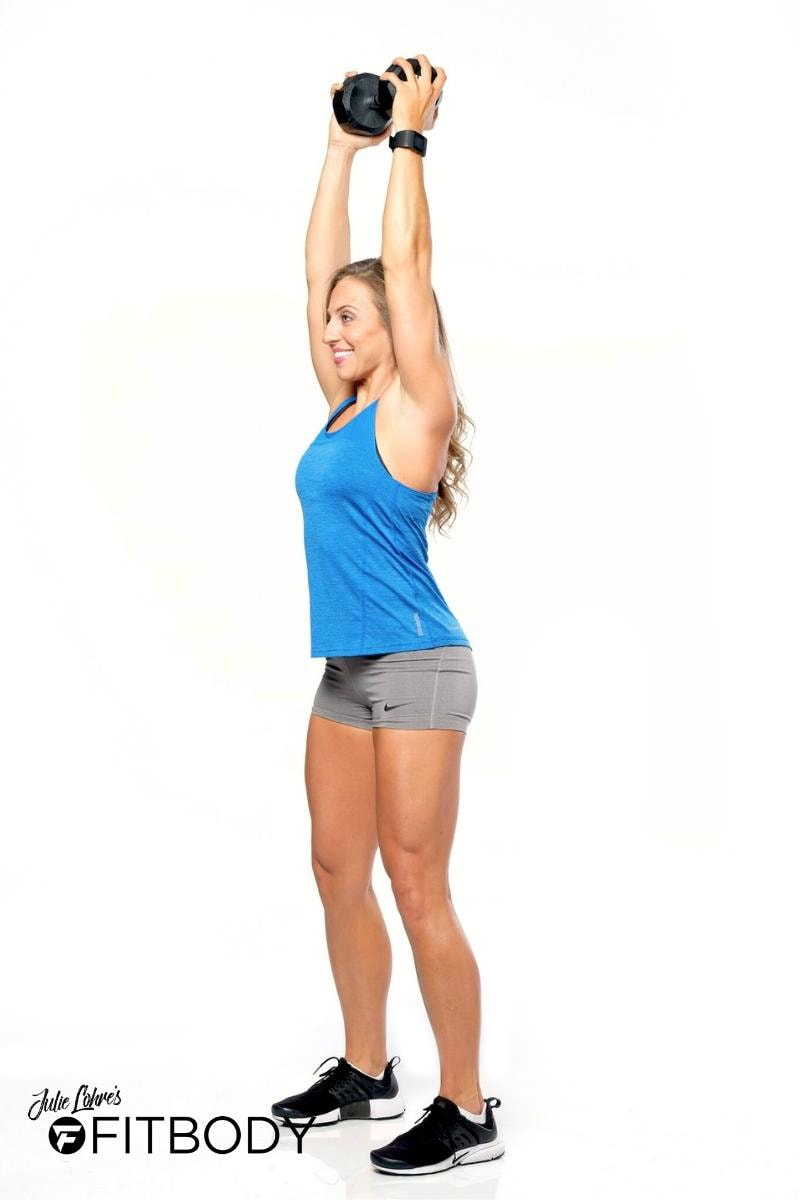
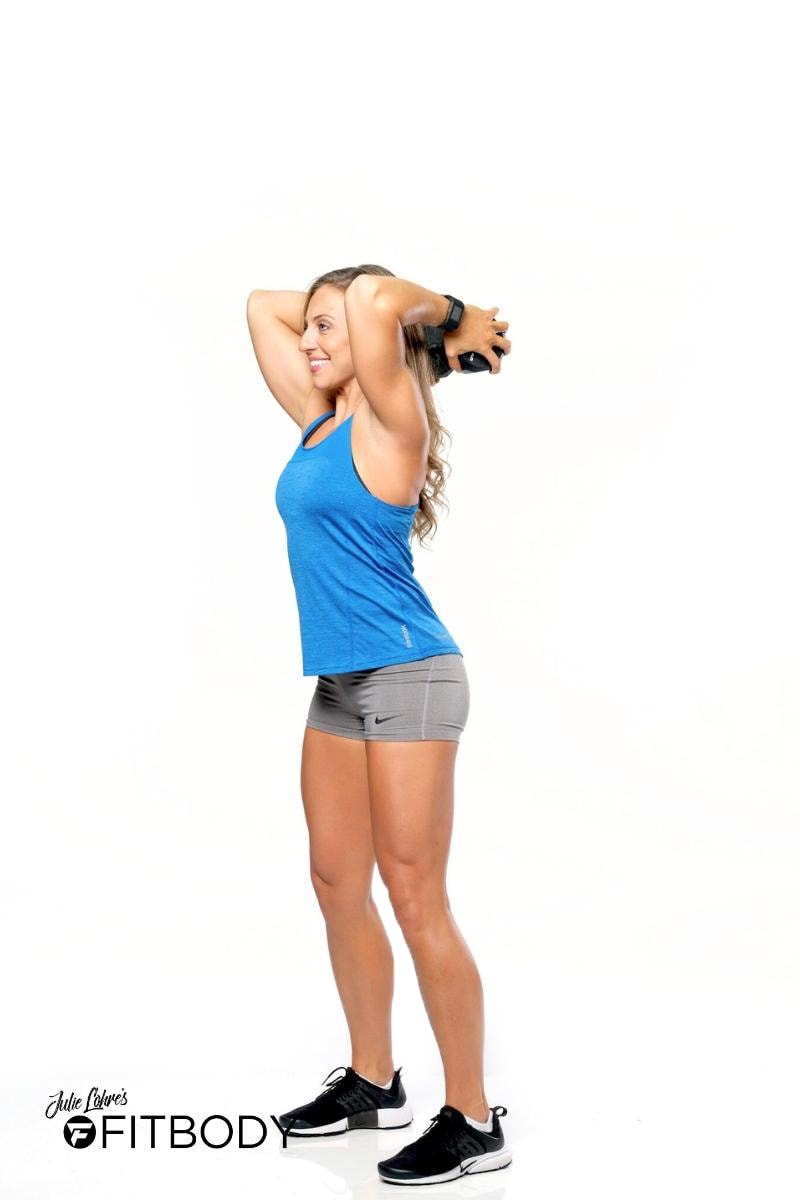
Whether you choose to do the dumbbell overhead tricep extension seated or standing, what sets it apart is its versatility and adaptability to different skill levels. Whether you’re a beginner or an experienced fitness enthusiast, you can easily adjust the weight of the dumbbell to match your strength and comfort level. This adaptability makes it an excellent choice for progressive overload, a key principle in strength training where you gradually increase the weight, frequency, or number of repetitions in your workouts.
Additionally, performing the exercise with a dumbbell requires a degree of unilateral (one-sided) effort, which can help in identifying and correcting any imbalances in arm strength. This aspect is particularly beneficial for ensuring balanced muscle development and reducing the risk of injury. The overhead tricep extension with a dumbbell is not just a tricep exercise; it’s a comprehensive approach to improving upper body strength, enhancing muscular symmetry, and building a solid foundation for advanced lifting techniques.
Alternatively, you can use a single dumbbell to work both arms at the same time.
Overhead Tricep Extension Barbell
Benefits of Using a Barbell or Curl Bar for Overhead Tricep Extensions:
- Heavier Weight Potential: Allows for lifting heavier loads, ideal for building significant muscle mass and strength.
- Symmetrical Muscle Development: Ensures both arms work equally, promoting balanced muscle growth.
- Variety in Grip Positions: Different grip widths can target various parts of the triceps, enhancing overall muscle development.
Drawbacks of Using a Barbell or Curl Bar for Overhead Tricep Extensions:
- Risk of Imbalance: If not lifted evenly, it can lead to muscle imbalances or strain.
- Limited Range of Motion: The fixed bar length may restrict the natural movement for some users, depending on their shoulder flexibility.
- Increased Joint Stress: The heavier weight can put more stress on the elbow and shoulder joints, especially if not performed with proper form.
Overhead tricep extensions with a barbell bring a unique dimension to tricep workouts by incorporating a compound movement that engages multiple muscle groups simultaneously. Using a barbell requires both arms to work in unison, promoting symmetrical muscle development and strength. This bilateral movement pattern is particularly effective for increasing overall upper body strength, as it not only targets the triceps but also engages the shoulders and upper back to a certain degree. The barbell’s structure allows for a heavier load to be lifted compared to dumbbells or cables, making it an excellent choice for those looking to build significant muscle mass and power. Additionally, the fixed path of the barbell helps in maintaining a consistent form throughout the exercise, which is crucial for targeting the triceps effectively and minimizing the risk of injury.
What sets the barbell overhead tricep extension apart is the challenge it presents in terms of stability and control. Balancing a barbell over the head demands a heightened level of coordination and core engagement, thereby enhancing core strength and stability. This aspect is particularly beneficial for athletes and individuals looking to improve their functional strength. Moreover, the barbell allows for variations in grip width, which can alter the emphasis placed on different parts of the triceps. A narrower grip focuses more on the long head of the triceps, while a wider grip can engage the lateral and medial heads more intensively. This versatility makes the barbell overhead tricep extension a valuable exercise for those aiming to comprehensively develop their triceps, contributing to both aesthetic muscle definition and practical upper body strength.
Overhead Tricep Extension Plate
Benefits of Using a Plate for Overhead Tricep Extensions:
- Enhanced Grip Strength: Gripping the edges of the plate improves hand, wrist, and forearm strength.
- Balanced Resistance: The uniform weight distribution of the plate ensures an even load on both arms.
- Simplicity and Accessibility: Plates are straightforward to use and commonly available in most gyms.
Drawbacks of Using a Plate for Overhead Tricep Extensions:
- Limited Weight Options: Plates typically offer fewer weight increments compared to dumbbells or barbells.
- Reduced Range of Motion: The size and shape of the plate may restrict the full extension and flexion of the arms.
- Awkward Handling: The flat, wide shape of plates can be more cumbersome to handle and position, especially for beginners.
Overhead tricep extensions performed with a weight plate present a unique challenge and variation to the traditional tricep extension exercises. Utilizing a plate, typically a round, flat weight, requires a different grip and muscle engagement compared to using dumbbells or barbells. This variation demands a more concentrated effort from the stabilizing muscles in the hands, wrists, and forearms, as the weight distribution in a plate is different from other equipment. The act of gripping the plate on its edges also adds an element of grip strength training, which is often overlooked in standard tricep exercises. Moreover, the uniform weight distribution of the plate provides a balanced resistance, ensuring that both arms work equally, promoting symmetrical muscle development and reducing the risk of muscle imbalances.
Another distinctive aspect of using a weight plate for overhead tricep extensions is its impact on the range of motion. The shape and size of the plate can sometimes limit the extent to which the arms can move, particularly at the lowest point of the exercise. This limitation can be beneficial as it keeps the triceps under constant tension, even at the peak of the movement, thereby intensifying the workout. The plate’s physical structure also encourages a more controlled, deliberate movement, enhancing muscle engagement and reducing the likelihood of relying on momentum. This focus on controlled movements is excellent for muscle endurance and strengthening. Incorporating a plate into overhead tricep extensions is a fantastic way to diversify a workout routine, challenge the muscles in new ways, and enhance overall upper arm strength and definition.
Overhead Tricep Extension Band
Benefits of Using Bands for Overhead Tricep Extensions:
- Progressive Resistance: Resistance increases as the band stretches, providing more tension at the peak of the exercise.
- Portability and Convenience: Bands are lightweight, easy to store, and perfect for home workouts or traveling.
- Joint-Friendly: The elastic nature of bands offers a lower impact on joints, reducing the risk of injury.
Drawbacks of Using Bands for Overhead Tricep Extensions:
- Limited Resistance Levels: Bands may not offer as much resistance as weights, potentially limiting muscle growth for advanced users.
- Durability Concerns: Bands can wear out or snap over time, requiring regular inspection and possible replacement.
- Inconsistent Tension: Unlike weights, bands do not provide a consistent level of resistance throughout the movement, which can affect muscle activation.
Overhead tricep extensions with resistance bands offer a distinct and versatile approach to tricep training. The unique property of resistance bands is their variable tension, which increases as the band stretches. This progressive resistance provides a different stimulus compared to the constant load of free weights or the steady resistance of a cable machine. As you extend the band overhead, the tension increases, demanding more effort at the peak of the exercise, which is excellent for building both strength and muscle endurance. The elasticity of the bands also allows for a natural movement path, accommodating the joint’s natural arc and reducing strain on the elbows and shoulders. This makes band overhead tricep extensions particularly beneficial for those with joint concerns or for adding variety to a workout routine to prevent overuse injuries.
Using bands for overhead tricep extensions is also unique in its practicality and accessibility. Bands are lightweight, portable, and can be used almost anywhere, making them ideal for home workouts, travel fitness routines, or as a complement to gym sessions. They come in various resistance levels, allowing for gradual progression or regression, depending on the individual’s strength and fitness level. This adjustability makes them suitable for all fitness enthusiasts, from beginners to advanced athletes. Furthermore, bands help in maintaining constant tension throughout the movement, including the usually less challenging return phase, enhancing muscle activatio

